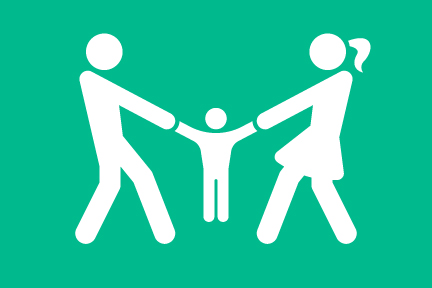Child Custody Explained

The “best interest of the child” is the legal standard that governs all child welfare issues, including custody arrangements. This means that even if an arrangement is not ideal for the parents, the court will choose the best custody arrangement for the child. Below are the most common types of custody arrangements and terms.
Legal Custody
Legal custody is when the parent is granted the right to make long term decisions about the manner in which the child is raised. This includes the right to determine the religion or lack thereof of the child, the type of schooling the child receives and attends, making medical decisions for the child, and other, major life decisions. Courts tend to award legal custody to both parents in most custody arrangements (“joint custody”) on the belief that both parents should share in making important decisions for the child.
Physical Custody
Physical Custody
Physical custody is when a parent is granted the right to have the child live with him or her. Depending on the amount of time the child spends with the parent, the parent is classified as either a “custodial parent” or a “non-custodial parent.” A custodial parent has primary physical custody of the child, and attends to the child’s day-to-day activities, welfare, schooling, and other needs. A non-custodial parent does not have primary physical custody rights, but is granted visitation based on his or her proximity to the child and the schedules of both the parents and the child. In most cases, the non-custodial parent is required to pay child support to the custodial parent.
Sole Custody
Sole Custody
Sole custody is when a parent is granted full custody of the child—legal, physical, or both. Most courts prefer to not grant sole custody unless the other parent is deemed unfit, either being a danger to him or herself or the child.
Joint Custody
Joint Custody
Joint custody is when the parents share custody of the child—legal, physical, or both. This type of custody is preferred by most courts, since the primary factor in determining custody arrangements is the “best interests of the child,” which usually involves spending time with both parents.
Typical Custody Disputes
Typical Custody Disputes
Child custody is a state law matter handled in family court. As such, the laws vary by state. Determining the type of custody arrangement appropriate in a given situation can be difficult for both the parents and the child. Although a parent can represent him or herself before the court in a child custody matter, having an attorney is essential if: 1) you and the child’s other parent disagree on what type of custody arrangement is appropriate; 2) if you contest the amount of child support that the non-custodial parent should provide; and/or 3) if you believe the other parent is unfit for joint custody.
If you have a child custody matter and need legal assistance from an attorney, post a short summary on www.legalserviceslink.com, and let the perfect attorney come to you!
If you have a child custody matter and need legal assistance from an attorney, post a short summary on www.legalserviceslink.com, and let the perfect attorney come to you!
Do You Need An Attorney?
If so, post a short summary of your legal needs to our site and let attorneys submit applications to fulfill those needs. No time wasted, no hassle, no confusion, no cost.

